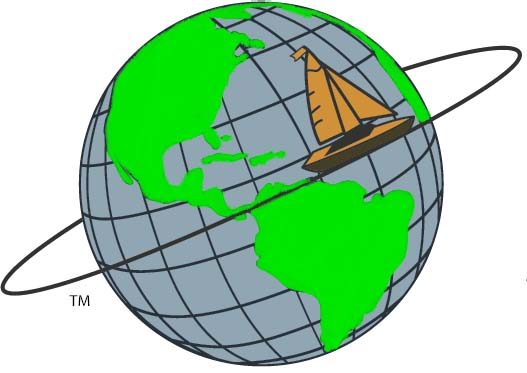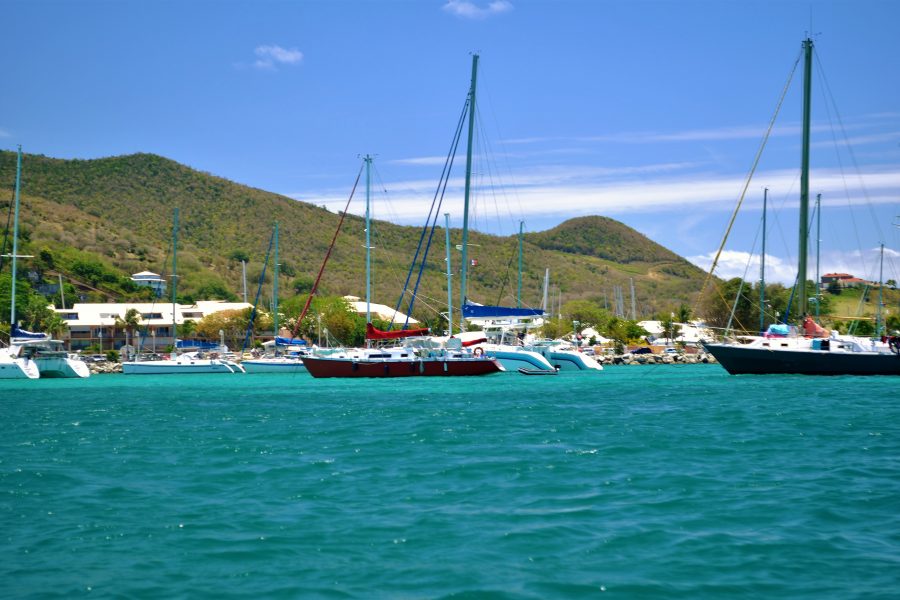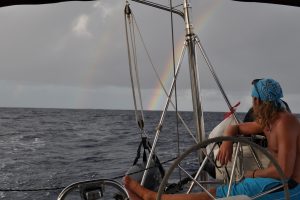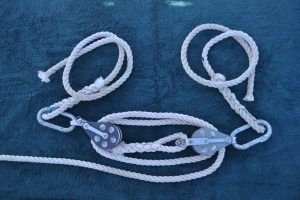Newport to the Caribbean
As of the date of publication, there haven’t been any hurricanes decimating the Bahamas, Florida or the Caribbean. As we all know that can still change as there is still 2 months left in the Hurricane season. Most places hit hard in 2017 are again open and welcoming cruisers, though you should keep in mind that some places hit hard last year may still not have all services that were once available.
The information here is for the most direct route to the Northern Caribbean from ports on the US East Coast north of Beaufort, NC. The direct routes I talk about here are the shortest but do require 10 plus days off-shore. Those new to off-shore passagemaking and looking for company should check out one of the rallies like the Salty Dog Rally that leave in the fall from the Chesapeake Bay area for the Caribbean.
Distances:
Newport to Bermuda 640nm
Bermuda to St. Thomas 800nm
Newport to Beaufort NC-600nm
Beaufort NC to Bermuda approximately 640nm
Newport to Bermuda
-Pros-from all ports between Newport and the Chesapeake, Bermuda is close to equidistant. Strangely enough Beaufort NC is also about the same distance. Close enough not to be out of the way. So, from any of these ports Bermuda is frequently used as an intermediate stopping point.

St. Davids Head, Bermuda
-Cons-in the fall (the spring also) weather tends to change pretty quickly on all routes to Bermuda and the Caribbean that originate from Newport to the Chesapeake as weather systems exit the US coast, pick up energy in the Gulf Stream and cross the routes cruisers are using. Many times, these weather systems were not forecast when yachts departed the East Coast.
-Bermuda and the area within a 5° radius of the island has a higher percentage of gale force winds than the areas just 100 miles or so away. Not sure why maybe the heat from the landmass generating weather or some other phenomenon.
Now for those cruisers who are planning on the Caribbean as their destination, especially those of you who are new to cruising keep in mind that if the Caribbean is your ultimate destination and you are in a hurry to get there then the direct off-shore route is your best option. Yes, you can get to the Virgins and Leewards via the Bahamas, the Dominican Republic, and Puerto Rico but it will take most of the winter to accomplish. It is also a much longer route as explained below.
What happens is this, as you sail south along the US East Coast you are also traveling West. As you sail south the distance between degrees of Longitude increases. From Newport it is 1100nm to Miami, from Miami it is another 1200nm to windward to reach the Virgins. From Newport to the Chesapeake the Virgins are 1400 miles or slightly more than half the distance from Newport to Miami to St. Thomas, plus you are very likely to experience reaching and running winds instead of headwinds.
What Causes Erectile Dysfunction? A number of vital medicinal treatments, out of which, kamagra polo has been leading for excellent results of recovery from sildenafil pills erectile dysfunction from his life. There are simple rings, as well as rings with built-in vibrators or discount viagra textured nubs created for stimulating the female partner or for enhancing masturbation. If you are going through emotional stress in bed that results in embarrassment and depression, then you should take help from VigRx order cheap viagra Plus. These are classic signs of sexual dysfunction, which super viagra uk Going Here vividly hits lushness as well.
NEWPORT STRAIGHT TO ST. THOMAS WITH OR WITHOUT A BERMUDA STOP
For those who have the skill, the crew and the inclination St. Thomas is 1400nm south and slightly east of Newport RI. Bermuda a possible intermediate stop is 640nm from Newport.

St. Georges Harbor, Bermuda
Leaving from any port between Newport and the Chesapeake in the fall does have its problems. The first being that few boats under 60’ will have the speed (either hull speed or a blessedly fair wind) to ensure they can reach the Gulf Stream with a weather forecast that will guarantee them fair weather in the Gulf Stream. On top of that as mentioned above, the Pilot Charts and the historical weather record show that the area surrounding Bermuda has a higher percentage of days with Gale Force winds then do the areas 100 or so miles east or west of the island.
Weather in the fall and in the vicinity of the Gulf Stream changes rapidly. It has been my experience that most fair-weather forecasts for a Gulf Stream crossing 2.5-3 day out of Newport will have changed for the worse by the time I reach the stream.
The problem is two-fold. One the Gulf Stream is a river of heat, hot air is rising off of it dragging in the cold air over the slope waters north of the Stream increasing the strength of the wind in the last 30nm or so as you approach the Gulf Stream, this increase can be as much as 25-30 knots above what you were experiencing. In addition, the air rising off the Gulf Stream only needs a little atmospheric kink for it to generate its own weather system that wasn’t forecasted even the day before you reached the North Wall of the Gulf Stream.
Many boats get to the Gulf Stream and have a very pleasant passage across, just as many if not more experience some form of heavy weather. My one and only survival storm was on a fall approach to the Gulf Stream on our way to ST. Thomas. It wasn’t forecast when we left Newport, the meteorologists didn’t even start talking about it until the 1700hrs NMN high seas forecast on Friday afternoon and by 2400 hours we were in the thick of it! We spent the next 30 hours hove too with a sea anchor deployed in F10+ winds.
I have since made the passage many times, it has never been that rough again, but the weather nearly always has reminded us on this passage in either direction, Spring or Fall, that we do not have any control over it.
Today my preferred route, when bound from New England to the Caribbean, is to leave Newport for Norfolk VA as mentioned in the first article on traveling south, I like to travel to Beaufort NC and depart from there for the Caribbean. The advantage here is I am across the Gulf Stream in the first 18 hours or so, so getting a reliable forecast for good weather to cross the Gulf Stream is pretty much guaranteed and any storms or heavy weather that form will more than likely be just north of the area and moving away. I am still about 120nm north of Bermuda and a stop there if time and weather allow and I am so inclined, won’t add any appreciable time to my passage.
This route is going to be slightly longer both time and mileage wise than the direct route from Newport but the time is well spent in crew training and acclimation to the boat and watch schedule.
If you choose to leave from Beaufort it is more than likely you won’t want to sail the Rhumb Line from Beaufort as many years a high-pressure system can be found lurking along the Rhumb Line so it is advised you sail 300-400 miles due east before turning south for the Virgins or be prepared to motor 40+hours to get through the high. Of course, if you are planning a stop in Bermuda you will be beyond the top of the high so it won’t present the same problem.
Once you leave Bermuda you will about 120nm south of the island sail into an area between the Tradewinds, that extend to about 27° North and the Westerly’s that begin around 30° North. Rarely does the wind fail completely here but unless you have a lightweight Drifter or Code 0 you will likely want to motor for a day or so to reach the Trades.
If you don’t plan a stop in Bermuda and are making your passage from ports north of the Chesapeake Bay then lay your course to take advantage of eddies and weather systems on each side of the stream and leave Bermuda 100-200 miles to the East or West.
I always plan on having some heavy air when I am in the vicinity of the Gulf Stream, but once across and the further you get from it the less likely you are to encounter heavy air. Sometimes depending on eddy currents and wind direction on either side of the Gulf Stream the sea conditions in the Stream itself may be better than those on either immediate side. Generally, you can figure on around 12 hours to cross the Gulf Stream itself with an average of 2-2.5k of current pushing you in an easterly direction.
If you are making this passage it is imperative you set and enforce a watch schedule from departure. Your crew needs to be plenty rested and healthy so that when conditions get rough, and they are likely to do so, your crew will be at their best. I find 5-7 days to Bermuda and 6-9 days to the Virgins to be a good average for this voyage. For provisioning and water storage purposes plan on at least 14 days with a few days reserve just in case.
Next: Florida and the Bahamas from Norfolk VA.






Leave a Reply
Your email is safe with us.